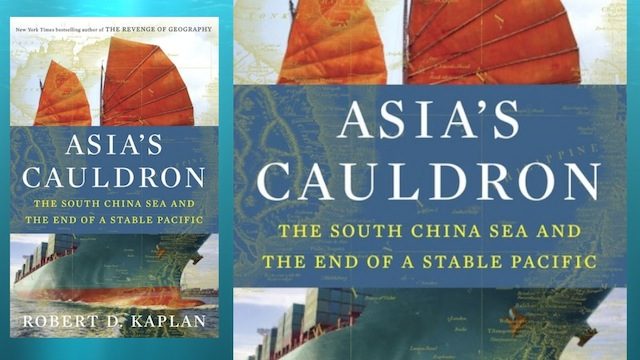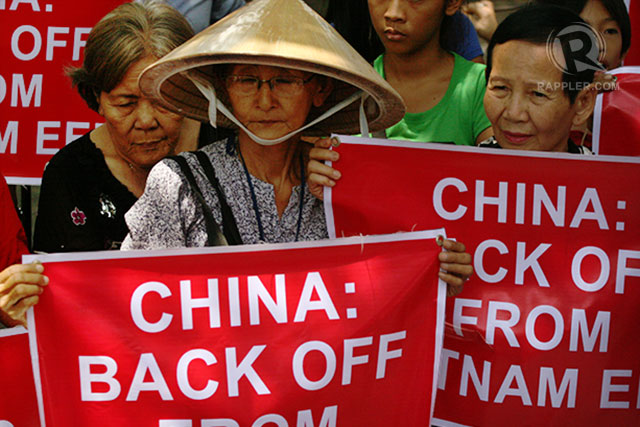SUMMARY
This is AI generated summarization, which may have errors. For context, always refer to the full article.

MANILA, Philippines – Geopolitical analyst Robert Kaplan begins his book on the South China Sea vividly describing the ruins of Champa Kingdom in central Vietnam, showcasing India’s pervasive legacy in a country with territories that were previously a part of China.
It’s a reminder, Kaplan wrote, of how powers and civilizations rise and fall. He gives the long view as the region concerns itself with containing China that is aggressively claiming almost the entire South China Sea.
“The shadow of China presently looms large, but if at some point very soon China dramatically falters, the South China Sea may once again live up to its French colonial description of Indochina, where China competes on an equal – rather than dominant – footing with India and other powers and civilizations,” he wrote.
The Philippines filed a case against China before arbitral tribunal at the Permanent Court of Arbitration. It is counting on the United Nations (UN) body to peacefully resolve maritime conflicts by telling China to recognize the 200-nautical mile exclusive economic zone (EEZ) of all countries provided under the UN Convention on the Law of the Sea (UNCLOS). (READ: Aquino: This battle is not just about China)
But Kaplan is not setting his eyes on the ITLOS to stop China from controlling an important seaborne trade route that is also potentially oil-rich. To Kaplan, ASEAN’s fighting chance is Vietnam.
“It’s all up to Vietnam,” Kaplan concluded in his book Asia’s Cauldron: The South China Sea and the End of a Stable Pacific.
“If China can break off Vietnam they’ve won the South China Sea,” Kaplan wrote quoting an unnamed US defense official.
Kaplan explained: “Malaysia is lying low, Brunei has solved its problem with China, Indonesia has no well-defined foreign policy on the subject, the Philippines has few cards to play despite that country’s ingenious boisterousness and incendiary statements, Singapore is capable but lacks size.”
Kaplan is the chief geopolitical analyst for private global intelligence firm Stratfor and a foreign correspondent for The Atlantic. Published in February 2014, the book captures the recent developments in the region. It is available on Amazon.com.
PH a ‘near-failed state’
The Philippines and Vietnam dominate the two edges of the South China Sea. Between them are the islands of Spratlys, some of them within the Philippines’ EEZ.
“Make no mistake, the Philippines is crucial: it dominates the eastern edge of the South China Sea as much as Vietnam does the western edge and China the northern one. With a population of nearly 100 million, the Philipipnes is more populous than Vietnam even,” Kaplan wrote.
But he looks at the Philippines as a “near-failed state with a military more focused on internal threats from communist insurgents and Muslim separatists.”
“The Scarborough Shoal affair made it obvious to the Filipinos – if it wasn’t obvious by then – that they needed a substantial military alliance with the US,” Kaplan wrote, referring to the 2012 standoff that Manila lost to Beijing. The shoal is now practically occupied by the Chinese Coast Guard.
But even the US can only do so much for a navy with capabilities as ancient as the Vietnam War. “The Americans had thought of selling the Filipinos a late-1980s frigate, but with a turbine engine it was judged to be too complex for them to maintain,” Kaplan wrote.
The Philippine Navy instead got the decommissioned 1960s US Coast Guard cutters, currently its most capable ships. (READ: PH Navy asking for 3rd warship from US)
The arbitration case of the Philippines, he said, is “the ultimate demonstration of weakness.” (Watch here retired Philippine Navy chief Vice Admiral Jose Luis Alano discuss what the navy has been doing to upgrade its capabilities)
Battle-hardened Vietnam
Tension between China and Vietnam countries turns scarily dangerous following China’s provactive move to deploy an oil rig near disputed Paracel Islands. Chinese and Vietnamese ships have gone past water cannon attacks to ramming each other, supposedly injuring Vietnamese crew.
On land, Vietnamese have launched deadly anti-China riots prompting China to evacuate more than 3,000 of its citizens out of Vietnam.

Vietnam is no match to China’s military might, but it will not make it easy for the neighbor it has been at odds with for centuries. Kaplan noted Vietnam’s recent US$2 billion spending on 6 state-of-the-art Kilo-class Russian submarines and $1 billion on Russian fighter jets.
Vietnam’s war history shows it is no pushover. It has defeated 3 world empires including China, which it was integrated to until the 10th century. China has never left Vietnam alone since.
Vietnam also used to a colony of France. The Vietnamese gained their freedom after humiliating French in the 1954 Battle of Dien Bien Phu.
And there was the unsuccessful US involvement in the Vietnam War to prevent a communist take over of South Vietnam.
In a good way, maritime disputes are fought very differently from land disputes that saw the violent clash of militaries, Kaplan wrote. The South China Sea shows maritime conflict may not necessarily lead to war but a careful interplay of soft power and hard power.
Vietnam and the US
Like many ASEAN countries, Vietnam is counting on the US to counter China’s aggressiveness.
“US presence is needed for a free maritime climate in the South China Sea,” Ngo Quang Xuan, the foreign affairs commitee vice chairman, was quoted in the book as saying.
Vietnam is also refurbishing Cam Ranh Bay, a deep-water anchorage that served as a “major base of operations for the US military during the American war.” Kaplan said the Vietnamese hope that it will facilitate stronger US military presence “to counter China’s rising power.”
At the same time, history taught the Vietnamese not to be entirely dependent on another country. “Because of the failure of the Soviet Union to help Vietnam in 1979, the Vietnamese will never again fully trust a faraway power,” Kaplan wrote.
A year after Vietnam invaded Cambodia to oust the pro-Beijing Pol Pot regime, China invaded the country to teach it a lesson. Vietnam was counting on its ally, the Soviet Union, to come to its rescue but was disappointed.
Kaplan also wrote about the fear of some Vietnamese that the US might betray them.
“There is the fear of the US selling Vietnam for the sake of a warmer relationships with China,” Kaplan wrote. An official told Kaplan how US President Richard Nixon’s strategy to develop relations with China in the late ’70s provided the “geostrategic context for China’s invasion of Vietnam.”
Kaplan curiously ends his book describing the slums of Borneo, a portion of the South China Sea where China is not the threat, but piracy, smuggling, and the illegal movement of people from one country to another.
“Borneo was indeed a throwback: a place that, like Champa in Vietnam, challenged my theories about the present – about how China was the principal reality; and about how it was all about warship, oil tankers, and modernizing autocrats,” Kaplan wrote.
He raised more questions. What if China is decentralized because of political and economic crisis? What if problems of piracy and refugee flows worsen?
All these can change the situation in the region, Kaplan said. “Don’t think of the region as necessarily going in one direction, in other words.” – Rappler.com
Add a comment
How does this make you feel?
There are no comments yet. Add your comment to start the conversation.